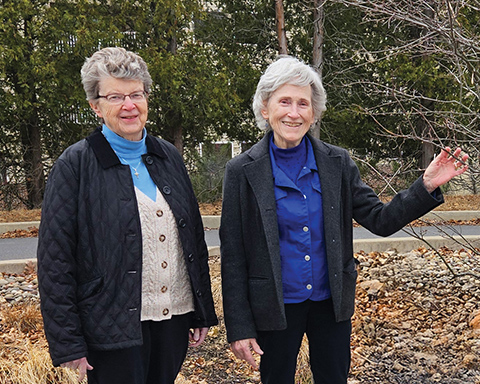Journey
Our Call to Live More Simply
The shock of the IHM Motherhose fire was the beginning of our call to live more simply and the beginning of our real spiritual renewal.
Imitation of Jesus’ self-emptying love leads us to holiness
and to utter simplicity of lifestyle, for this self-emptying
love must take us to the poor, the sick, the persons
with disabilities, the underprivileged, the persecuted and the dying.
The year 1971 was a momentous one in the salvation history of the Sisters, Servants of the Immaculate Heart of Mary, Scranton, Pennsylvania. On the fateful night of February 22, 1971, our IHM Motherhouse burned to the ground. As Director of Novices at the time, I was living at the Novitiate, now the IHM Center. From a third-floor window, I could see the inferno and thought to myself, our junior sisters living on the fourth floor will never make it out alive, but by some miracle of God’s Divine Providence, no lives were lost. That night all of our sisters living in that Motherhouse, including the professors and staff at Marywood College, now Marywood University, lost everything they had. The shock of that event was the beginning of our call to live more simply and the beginning of our real spiritual renewal.
At the 7:00 a.m. celebration of the Eucharist the next morning, our sisters in bathrobes, bedroom slippers and whatever clothing they could find were all there in the chapel. The opening hymn was “God Gives His People Strength.” It was planned the week before the fire, and, indeed, God’s strength and healing prevailed.
That same year, 1971, was a momentous year for me personally. I found myself in Rome, Italy, in September enrolled in the ARC Program (Apostolic Religious Communities) for English speaking women religious. Most of the sisters were directors of formation programs. We were taught by Jesuits from all over the world. Paul Molinari, S.J., the director, was from Rome. Passionist priest, Barnabas Ahern, taught us all that could be known and written by St. Paul. A woman religious, Mary Milligan, from Marymount University, taught the Old Testament. The immersion in the Scriptures and the contemporary challenges from Mother Theresa of Calcutta integrated our Gospel focus toward “living simply” in a very powerful way.
David Stanley, S.J., taught the Gospel of St. John. It was this class that took hold of me, and I have never stopped loving this Gospel for more than fifty years. It was a pure gift for me, and I taught it for many years afterward.
Now in retirement at Our Lady of Peace Residence, the mystical Gospel often referred to as the “eagle in flight” continues to inspire me. In the most recent Direction Statement from our Chapter of 2022, we IHMs proclaimed our desire to empty ourselves so as to commit ourselves in all simplicity to being a mystical presence in our world.
In his book Arise, My Love: Mysticism for a New Era, William Johnston, S.J., explains that in his forty years in Japan, he experienced many views of Jesus as a mystic from interactions with the Dalai Lama and many other mystical masters. What attracted all these lovers of Jesus from other faiths was his kenosis—his total self-emptying. For the life of the world, Jesus accepted the loss of everything and embraced his death on the Cross.
The early Christians saw Jesus as more than a prophet and more than a mystic. Jesus was the Son of God who existed before He was born of Mary. John the beloved stated in the prologue to his Gospel, “The Word became flesh and dwelt among us” (Jn. 1:14). This doctrine appears with clarity in the famous hymn in Paul’s letter to the Philippians 2:5-11: “Though Jesus was in the form of God, He did not regard equality with God as something to be grasped. Rather, He emptied himself, taking the form of a slave” (Phil. 2:6).
God’s story is one of love and can be found throughout John’s Gospel, beginning with Jn. 3:16. “God so loved the world that God gave an only Son, so that everyone who believes in Jesus might not perish but might have eternal life.” The Father loves the Son and shows Jesus all that He is doing (John 5:30). Jesus, too, loves the Father and from their mutual love proceeds the Holy Spirit. This is the heart of the mystical experience of Jesus. In a Spirit of Love, Jesus cries out, “Abba, Father,” and it is an interpersonal love leading to a mutual indwelling. It is the mysticism that Christians call trinitarian, and it is one of the chief characteristics of Christian mysticism.
This trinitarian love brings total unity so that Jesus can say, “The Father and I are one.” (John 10:30). A second aspect is one of intimacy or familiarity so that Jesus speaks to the Father with great confidence “Father, the hour has come; glorify your Son” (John 17:1).
In John’s Gospel Jesus says, “I am the good shepherd. The good shepherd lays down his life for the sheep” (John 10:11). Jesus understands that He is sent by the Father in all humility and simplicity, to lay down His life for humanity. We can never forget these words of Jesus, “No one has greater love than this, to lay down one’s life for one’s friends” (John 15:13).
Jesus became a model for mystics of the third millennium. He certainly is a model for Christians; however, Hindus, Buddhists and Muslims have been influenced by the mysticism of Jesus even though they do not accept the dogmas of the Christian church. These religions resonate with the kenosis or the self-emptying of the Crucified Jesus. We might even be able to speak of Jesus as the model of all simplicity, as the architect of all mystics.
The response is always love. Consider Paul’s words: “I decided to know nothing among you except Jesus Christ and Him crucified” (1 Cor 2:2).
The same is true for Francis of Assisi who, leaving all behind, experienced the wounds of Christ’s kenosis in his body; and lastly in the self-emptying love of Edith Stein who refused her chance of freedom and went to her death in the gas chambers of Auschwitz to share in the fate of her Jewish brothers and sisters.
We have superb examples of the ultimate simplicity of giving it ALL in love. Imitation of Jesus’ self-emptying love leads us to holiness and to utter simplicity of lifestyle, for this self-emptying love must take us to the poor, the sick, the persons with disabilities, the underprivileged, the persecuted and the dying. In simplicity, we are wholeheartedly aligned with the mind and heart of Jesus Christ and relate to our brothers and sisters as Jesus taught us, with unconditional love and complete purity of heart. So, let us “live simply that others might simply live” (Mahatma Gandhi).



